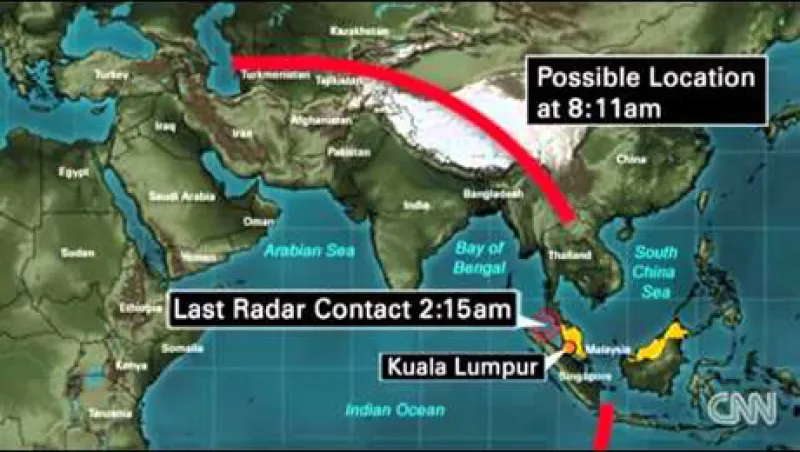Malaysia Airlines flight 370 had been missing for longer than any other aircraft before a statement early this week by the Malaysian prime minister was finally able to confirm that the plane had crashed in the southern Indian Ocean. For weeks, baffled officials and terrified family members from a dozen countries asked themselves and each other what had happened, and where the plane had gone. How was the Malaysian prime minister able to confirm the fate of a plane that, as of that declaration, had not been found? Popular media, such as CNN, implored officials with headlines such as “WHERE IS THE EVIDENCE?”. Clearly, they were far more used to evidence coming from pictures of wreckage than from obscure, “groundbreaking number crunching” and big data science.
We don’t know why the plane’s course was diverted, or who diverted it, but at least there’s been some official declaration of the fate of the flight and its 227 passengers. The search for flight 370 has also shown us that, though we asked our questions in the past tense (what happened?), a special kind of forecasting — a new way of thinking about potential future outcomes — is what finally ended the search.
Flight 370 was lost for so long because it left behind it only a handful of clues: a last radio check-in as the flight deviated from its northeastern flight path to turn east and south, toward the Indian ocean; an electronic handshake between plane and a station on the ground registered by a satellite; a blip on Malaysian military radar. Another partial handshake between the flight and the same satellite was disclosed by the Malaysian government only days ago — but that was all officials had.
Faced with an almost complete data blackout, veritable flotillas of equipment — submarine-detecting marine patrol planes, satellites to photograph floating debris, boats equipped with radar and other deep-sea listening devices — swept an area CNN has estimated at roughly the size of the continental U.S. That’s an immense amount of territory for any hunt; to call the plane a needle in a haystack is a dramatic understatement. For days, attempts to predict where a flight might have gone, based on all those partial clues, could only narrow the possible location of the plane to anywhere along two trajectories, one northern (between Thailand and Kazakhstan) and one southern (between Indonesia and the Indian Ocean).
That was until the Malaysian government confirmed that analysis performed by London-based British aviation investigation firm Inmarsat had totally eliminated the northern trajectory. Unlike the fleets of ships and aircraft dispatched to possible crash sites, Inmarsat focused on determining how to use the miniscule data points already gathered. The Inmarsat team compared the difference between the radar signal given off by the plane and what would have been expected at that radar station. They then applied insights into motion and sound — in this case, a specific form of the Doppler effect — to determine the plane’s speed. Performance data from Boeing helped them further eliminate scenarios until they had found “frankly a perfect correlation,” according to a company spokesperson.
Crucial here is that Inmarstat wasn’t trying to acquire more information from the field. Its team was dealing in the realm of the retrospectively possible, based on the smallest signs already gathered — that’s how they found the plane. It’s a clumsy formulation, but it would be less precise to say that Inmarstat was trying to determine what had happened than to say they were trying to determine what could have happened to the finest possible degree of accuracy. They took an odd, almost imperceptible difference between a precedent (the ordinary strength of a radar signal released by a plane on the original Malaysia Airlines route from Kuala Lumpur to Beijing) and an actual result (the strength of flight 370’s radar signal). They derived from that distance the confidence to negate the most important competing scenario (in this case, the northern trajectory). They proceeded accordingly, eliminating more scenarios along the southern trajectory with performance information provided by Boeing as to how far the plane could have traveled given its newly determined speed.
Generally speaking, oddities like the kind on which Inmarstat based its successful, retrospective prediction — these blips, slight irregularities — are far more significant than we think when we try to ponder the future. Weak signals might open new avenues for any other undertaking interested in predicting future events. The New York Times reported that the U.S. Navy has sometimes been almost unnervingly successful in locating missing vessels by running probability analyses on multiple scenarios based on weak signals. Analysts determine what could have happened, in the conditional tense, then assign probability points to each. Action is taken — searchers are dispatched, for instance — according to the results of statistical analysis.
It seems almost obvious to say that finance could be powered by such forms of prediction. It is less obvious, perhaps, that successful predictions seem to rely increasingly on technologies that aggregate rich streams of data such that weak signals become ever clearer and easier to spot. Philip Tetlock, a professor of psychology and management at the University of Pennsylvania’s Wharton School, has said that when it comes to geopolitical events it is wise to look to scenario planning driven by weak signals — a form of prediction that looks for small shifts preceding what would otherwise feel like a surprise, or a radically unpredictable, black swan event. “Pooled forecasting” in particular helps “weak signals from diverse experts accumulate clearly,” according to Tetlock.
There is no immediate reason why weak signals wouldn’t also be true and valuable for identifying consumer trends and market shifts. Slight deviations from established norms reveal themselves as strong signs if we know how to look for them. (Tetlock provides a number of ideas for how to look for such signs, including an endorsement of journalist James Surowiecki’s wisdom of crowds, in a recent review of several books on financial and geopolitical forecasting for the National Interest.)
In whatever context, however, our acceptance of future studies — the field of predictive thinking and its component disciplines — remains qualified. Results are not guaranteed, and in certain instances, these results are even more insufficient or unacceptable on their own. On March 25, Chinese families began to protest Malaysia’s announcement, insisting that we cannot know that the flight went down where Inmarsat has suggested until physical evidence is found. Given that the southern Indian Ocean is subject to some of the most violent oceanic conditions on the planet, we may never acquire physical proof.






